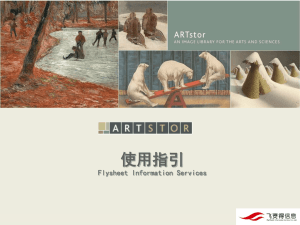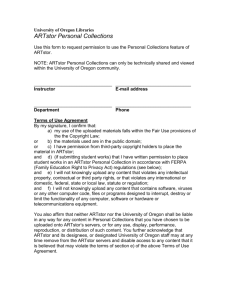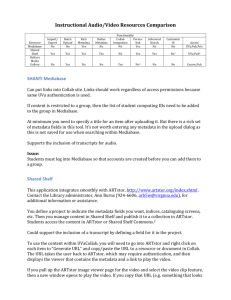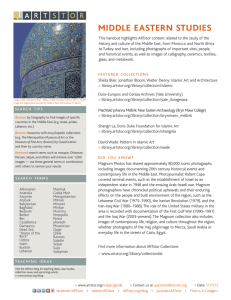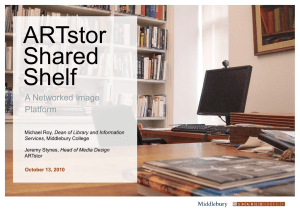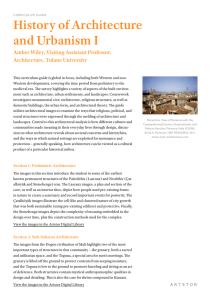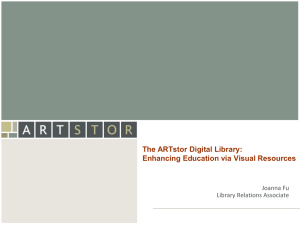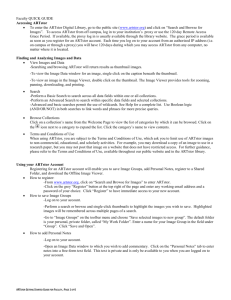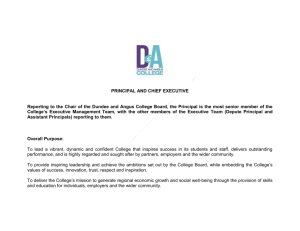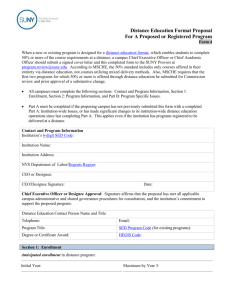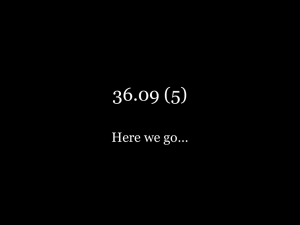CCUMC video summary notes
advertisement
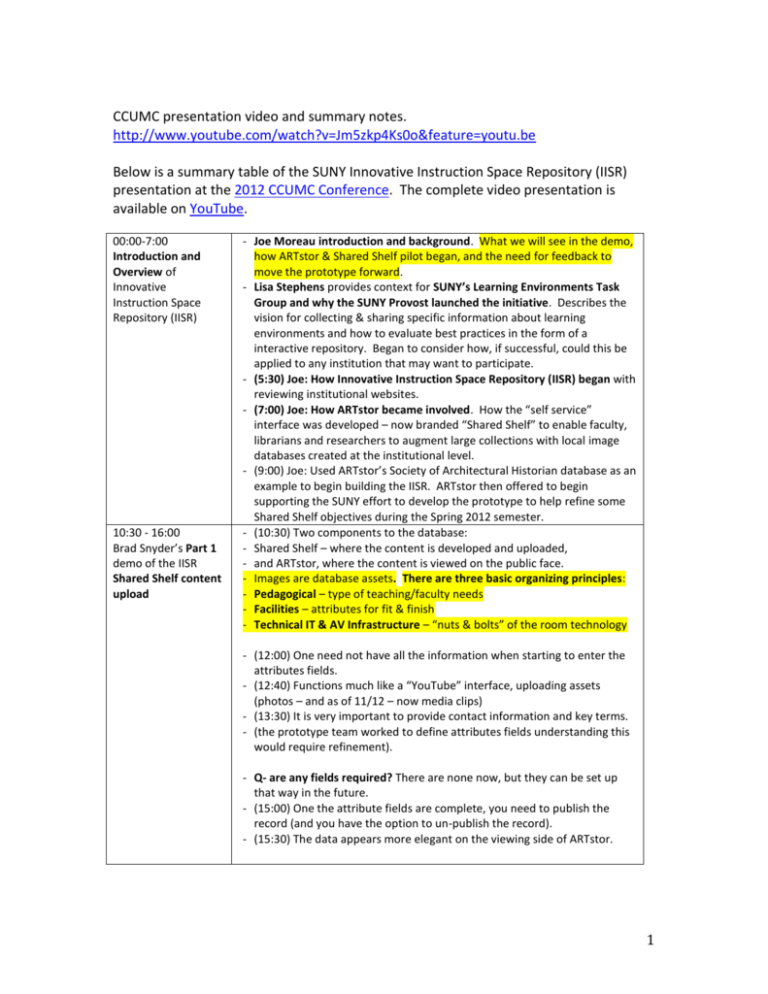
CCUMC presentation video and summary notes. http://www.youtube.com/watch?v=Jm5zkp4Ks0o&feature=youtu.be Below is a summary table of the SUNY Innovative Instruction Space Repository (IISR) presentation at the 2012 CCUMC Conference. The complete video presentation is available on YouTube. 00:00-7:00 Introduction and Overview of Innovative Instruction Space Repository (IISR) 10:30 - 16:00 Brad Snyder’s Part 1 demo of the IISR Shared Shelf content upload - Joe Moreau introduction and background. What we will see in the demo, how ARTstor & Shared Shelf pilot began, and the need for feedback to move the prototype forward. - Lisa Stephens provides context for SUNY’s Learning Environments Task Group and why the SUNY Provost launched the initiative. Describes the vision for collecting & sharing specific information about learning environments and how to evaluate best practices in the form of a interactive repository. Began to consider how, if successful, could this be applied to any institution that may want to participate. - (5:30) Joe: How Innovative Instruction Space Repository (IISR) began with reviewing institutional websites. - (7:00) Joe: How ARTstor became involved. How the “self service” interface was developed – now branded “Shared Shelf” to enable faculty, librarians and researchers to augment large collections with local image databases created at the institutional level. - (9:00) Joe: Used ARTstor’s Society of Architectural Historian database as an example to begin building the IISR. ARTstor then offered to begin supporting the SUNY effort to develop the prototype to help refine some Shared Shelf objectives during the Spring 2012 semester. - (10:30) Two components to the database: - Shared Shelf – where the content is developed and uploaded, - and ARTstor, where the content is viewed on the public face. - Images are database assets. There are three basic organizing principles: - Pedagogical – type of teaching/faculty needs - Facilities – attributes for fit & finish - Technical IT & AV Infrastructure – “nuts & bolts” of the room technology - (12:00) One need not have all the information when starting to enter the attributes fields. - (12:40) Functions much like a “YouTube” interface, uploading assets (photos – and as of 11/12 – now media clips) - (13:30) It is very important to provide contact information and key terms. - (the prototype team worked to define attributes fields understanding this would require refinement). - Q- are any fields required? There are none now, but they can be set up that way in the future. - (15:00) One the attribute fields are complete, you need to publish the record (and you have the option to un-publish the record). - (15:30) The data appears more elegant on the viewing side of ARTstor. 1 16:00 Q&A start re: Shared Shelf file upload component 20:00 Part 2 Demo ARTstor display and navigation - -Future directions (ARTstor announced multimedia and multiple image types the day before Annual EDUCAUSE Meeting) - -Can “cut & paste” attributes, or defined a master for multiple records. - -File size limit? (not that we’re aware of) – may be some limits on file types, but that’s on their roadmap. - -There may be options to upload control code strings in the future, there’s lots of opportunity. - -Did Jim Twetten's folks (Iowa State) have any difficulty uploading content? (no, it was very intuitive without directions). - Image display & features - (20:48) Brad: When I attend conferences like this, one of the most valuable aspects is visiting other campuses to see how they solve problems that we face. (This tool becomes a way to efficiently replicate, in part, that experience.) - (21:12) Here are some of the images uploaded from Iowa – they are decent sized images. - (21:30) There are not a lot of images uploaded yet as part of the prototype, but they are high quality images (54 records uploaded at the time of this presentation) 22:30 Q - Do you need creds to search? - Yes, but hopefully not once we get to production. - Joe Moreau: Need some feedback to move forward on how to set this system up for expansion. - The concept is to create a tool that is free resource to education where you do not need to be an ARTstor subscriber to have access to the published space. - These are the logistical questions that need to be worked out as part of a future governance model. 23:20 Tools Tour on Interface - 26:30 – Q- is there a cost, how do I get started? Side-by-side view (compare and contrast) Can zoom in/out on the image while still viewing the attributes Would you like to see that in Khaki? (now THAT would be cool!) We gave the login information to the CCUMC board of directors, not everyone in the room has it. - Information can be published to a free site where you don’t need to be ARTstor subscriber. - That’s where we need your help, and the help of others to figure out how to move a good idea forward. - Copyright? What if you want to protect something? (Well, the golden rule is don’t publish it if you really want to protect it.) 2 27:40 – Q - Why ARTstor? - (Joe Moreau) Partly through happy accident, but mostly because of a good fit. There are lots of talented developers around SUNY, but we wanted to make sure this idea was sustainable and not reliant upon us (any individual campus resources). Didn’t want to steal anyone’s “spare time.” Lots of people can do it, but it makes more sense to have a hosted solution with a core competency in these services. - Foundation for moving toward broader exploration. - Not locked into ARTstor, but it’s a very robust tool and should be considered. - We need to develop the diversity of institutions, pedagogical practices and a more comprehensive resource – a larger critical mass as a national resource. Who should be the national custodian? CCUMC? EDUCAUSE? Somebody else? Someone other than SUNY? It could be a model similar to MERLOT. - How do we make it fiscally sustainable? ARTstor has been committed to working with us, and have expressed commitment to help further develop the logistics, refining the record model, but at some point in time they will need to see a revenue stream. ARTstor is a not-for-profit corporation, but they have real costs as well. - Need to have a governance structure to determine who is/are the custodian(s). 31:00 – Who decides what constitutes an “innovative design?” - General discussion. Can anybody submit anything up and call it “innovative”? Or, should there be some kind of moderation model? A group of peers might review a submission and score it in some fashion. - ARTstor has suggested from their experience with the architectural historians, there members upload any numbers of records, there is no peer review, but there is an “editors choice” where a panel decides what to escalate to a select list of samples. That might be a good model for this solution. 32:00- Peer Review Process? - This the vision for where we hope to adapt MERLOT’s peer review process. (NOTE: post CCUMC discussion. This is the vision for where we hope ELI’s active learning rubric under development can be helpful. ) 33:00 - who can access/what should the governance be? - This needs work and further input. Hopefully we can adapt a sponsorship model for a low cost or no cost model to higher edu. - Will we moderate? Can we use a “Netflix” or “Amazon” type rating system? 3 34:00 Who should consume this resource? - Some of suggested that they have no problem sharing their images and content with other higher edu peers, but express some reservation about whether architects should benefit from their investment. - Who gets access at what cost? Perhaps there’s a model where higher education can have free access, but other parties need to pay a subscription cost to have access to the data. Architects and engineers could pay to access the resource that could offset the cost of administering the system over time. 35:00 Can pull records and publish in different environments - Need to have a governance structure - Can easily publish to other places, lots of options to publish to ARTstor, or to other places – open shelf resource – or any other place or combination of places. - But we don’t know how to structure this without the governance structure to facilitate the conversations. - Can be published to Flickr, or any other open resource. 36:00 “need a very friendly user interface “ - How do we ensure that it's user friendly? - Shared shelf is not yet familiar to people, but ARTstor has a pretty good reputation. - Brad – only 8-10 schools have submitted samples, we did not train anyone; provided the creds and people figured it out. 37:00 - Any technical issues - ARTstor? - At time of writing, need to use Firefox - IE has a javascript error) 38:30 – Can multiple images be tied to single data? - Vision was to have a single record with all the data linked to that space, - Looking to have multiple images tied to a single record. That’s not where it is today, but ARTstor is looking to update this. We’ll work with them to see if we can build out that functionality. 39:30 Can this be used to upload all institutional records? - Looks great - can a campus use it as a repository for internal - use? It would be great if we could use this from an institutional perspective to tag records and use for our campus alone. - Brad – don’t know if you’d want to place all your images into this solution, but that’s an idea worth exploring - might be able to maintain content in one place, but publish in another - like a campus website. 4 41:00 – “ Can we upload all our institutional spaces to this tool?“ What is the definition of “Innovative.” - Need a schema to describe classroom spaces to make it easier to exchange information - (NOTE: Post Presentation Conversation – what is the status of the ELI Active Learning Rubric?) - As a byproduct, if we could have something that’s interchangeable between the institutional level and this solution, that might be very helpful. We all have institutional solutions – (this might be more cost effective.) - Lisa: We tend to think of Innovative as having “Wow factor”- but it’s also innovative to come up with a cost effective solution that can be replicated in a uniform manner. Perhaps an editorial board can help with that. 41:30 “CIC (Big 10) is looking for a similar solution, how can we help?“ 43:00 Collaborating with facilities people – how it functioned as part of IISR development. - Great start. As we begin to look at the flipped (classroom) model, we’re working more closely with our facilities people to explore all the attributes (change in seat counts, before/after renovations) as part of lifecycle. - On the CIC committee, looking at how to best share innovations across multiple institutions. (Indiana U) - Joe – well here you go! - We were often times working with 30 year old facilities standards. We found as a group that this tool would be helpful to both the construction fund stakeholders (system admin. Facilities design) and to faculty and instructional staff representatives within SUNY. - We are excited to try and help with a resource that defines “an active learning classroom” we can update classroom standards (ELI Rubric?) 45:00 Challenge of renovating space - Need Innovative Instruction Space Repository to help with multiple needs. - The UNLV president described in his talk about difficult it is to envision the seat space and scaling to current needs. It’s powerful to see the images for (room configuration). 46:00 Evidence of Impact to campus leadership - Love this idea, best part of coming to CCUMC is the campus tour, but this tool would help us stay competitive – to see what peers are doing. I want this to work. 46:30 Governance models next steps. - (Joe) There needs to be a governance body - need a broader group of colleagues from a variety of institutions. The answer to some of these basic questions will help determine what we need in terms of financial resources and staffing needs. - CCUMC might be a good partner, EDUCAUSE, others... these conversations will help guide the governance structure and sustainability. 5 48:30 Future sustainability issues around staffing/support/long er term - Help through sponsorship model or similar. Might be a quarter to half FTE longer term to help maintain the system and validate users, etc. (Post discussion – much of this can be automated through subscription definition and secure web transactions). - We might talk with about sponsorship, it wouldn't take a ton of money, there’s lots of interest, and it wouldn't cost a lot. The governance structure is key to next steps and adds credibility. 50:30 Sponsorship Issue Question - Concern expressed about the type of sponsorship model (vs. commercials) 51:30 CCUMC vendor membership - Joe- I wasn’t suggesting they (sponsors) would upload content, we were thinking the sponsorship model would be limited to their logo, and opportunity to describe and display content to potential customers. - CCUMC has vendor members, provides an opportunity for feedback and potential integration of ideas into product development cycles. It’s a unique opportunity to potentially use this tool. 52:50 Potential value to sponsors - Might be able to add or offer different levels of information. If there's a subscription based fee for a campus to upload their entire campus content, that might save a lot of trouble at the campus level; - If institutions want to develop a new database, it might be more cost effective to migrate an entire database onto a hosted solution rather than internally developing a solution. 53:50 Wrap up - Need to organizationally pursue. Please provide information back to the CCUMC board. 6
